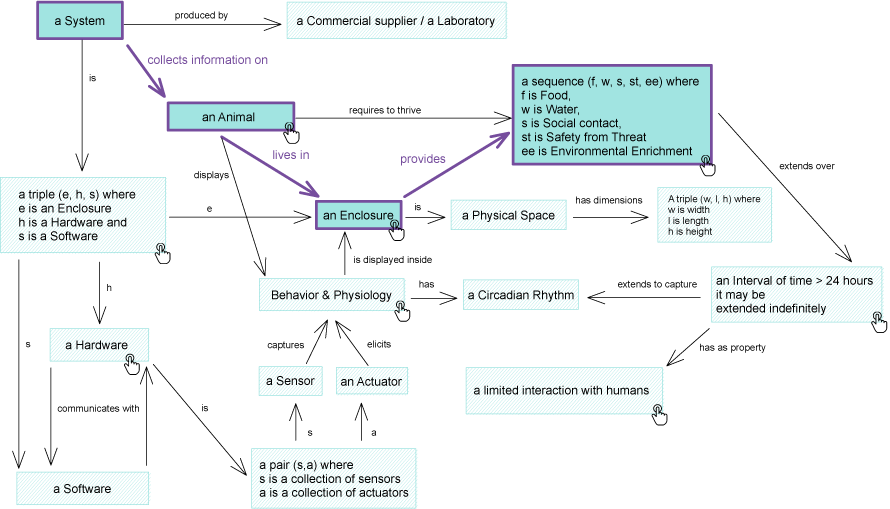Ologs are graphical tools used to describe objects and their properties [1]
The Olog depicted below delivers the representation of the object “Home Cage monitoring system”
Intertwined inside the olog, there are two key definitions: the animal and its behavior, and the analytical system.
While we strived to follow the formal approach needed to build a proper Olog, here we present a simpler version (e.g. arrows do not necessarily represent functions/maps)
Click the boxes with the hand icon to reveal more infromation

[1] Spivak DI, Kent RE (2012) Ologs: A Categorical Framework for Knowledge Representation. PLoS ONE 7(1): e24274. https://doi.org/10.1371/journal.pone.0024274
How to read the Olog
The definition of a HCM using natural language can be given by following the purple arrows and connecting the boxes with words like “which” or “that”
In this case the definition is: A system that collects information on an animal which lives inside an enclosure that provides food, water, social contacts, and environmental enrichment.
While this definition is correct, it fails to capture the defining details that make up a full-fledged definition of HCM
Enhanced version
This enhanced version is an attempt at capturing, using a more formal structure, the multifaceted nature of HCM systems.
In principle, by following boxes and arrows of the Olog , it would be possible to:
- Decide whether an unknown system falls in the category of HCM,
- Understand key parameters needed to report in an article to define the experimental settings used for the HCM experiment.
Click here to download a full-fledged version of the HCM olog.
An Animal
Any animal that can be observed either in a laboratory setting or in a farm setting
Enclosure, Hardware and Software
This is the definition of an analytical system used to capture behavior and physiology. It consists of an enclosure, hardware and software.
An Enclosure
Enclosure is a physical place delimited by walls, floor and, optionally ceiling. It has physical dimensions that must be reported in papers
Food, Water, Social contracts, Safety from threats, environmental enrichment
All these elements are necessary for an animal to thrive when living inside an enclosure
A Hardware
Any piece of equipment that communicates with software to capture or elicit the behavior, or physiology of an animal inside the enclosure. Hardware contains a sensor and an actor. These two elements may not necessarily be present at the same time.
Behaviour and Physiology
Behavior is defined as a collection of visible movements, while physiology may be any collection of biological processes (e.g. hear rate, respiration …)
Interval of time
Animals must be housed in the HCM for at least 24 hours in order for the system to be able to capture a circadian rhythm
Limited Human Interaction
A key property of all HCM systems is the limited human-animal interaction they provide. The animal is left undisturbed for protracted stretches of time, in order to allow the system to capture natural behavior.